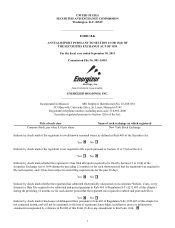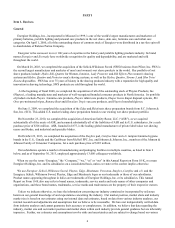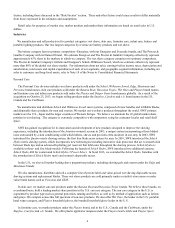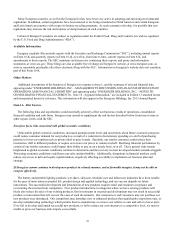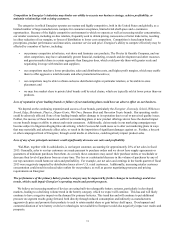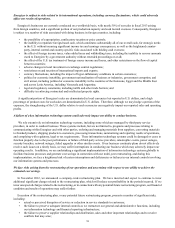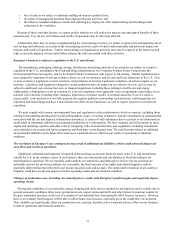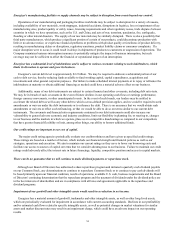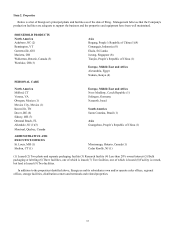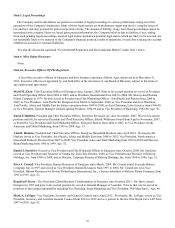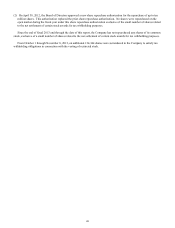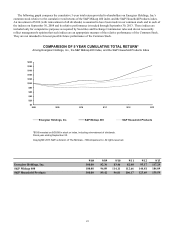Energizer 2013 Annual Report Download - page 21
Download and view the complete annual report
Please find page 21 of the 2013 Energizer annual report below. You can navigate through the pages in the report by either clicking on the pages listed below, or by using the keyword search tool below to find specific information within the annual report.Competition in Energizer's industries may hinder our ability to execute our business strategy, achieve profitability, or
maintain relationships with existing customers.
The categories in which Energizer operates are mature and highly competitive, both in the United States and globally, as a
limited number of large manufacturers compete for consumer acceptance, limited retail shelf space and e-commerce
opportunities. Because of the highly competitive environment in which we operate as well as increasing retailer concentration,
our retailer customers, including on-line retailers, frequently seek to obtain pricing concessions or better trade terms, resulting
in either reduction of our margins, or losses of distribution to lower cost competitors. Competition is based upon brand
perceptions, product performance and innovation, customer service and price. Energizer's ability to compete effectively may be
affected by a number of factors, including:
• our primary competitor in batteries, wet shave and feminine care products, The Procter & Gamble Company, and our
other competitors, may have substantially greater financial, marketing, research and development and other resources
and greater market share in certain segments than Energizer does, which could provide them with greater scale and
negotiating leverage with retailers and suppliers;
• our competitors may have lower production, sales and distribution costs, and higher profit margins, which may enable
them to offer aggressive retail discounts and other promotional incentives;
• our competitors may be able to obtain exclusive distribution rights at particular retailers, or favorable in-store
placement; and
• we may lose market share to private label brands sold by retail chains, which are typically sold at lower prices than our
products.
Loss of reputation of our leading brands or failure of our marketing plans could have an adverse effect on our business.
We depend on the continuing reputation and success of our brands, particularly the Energizer, Eveready, Schick, Wilkinson
Sword, Edge, Skintimate, Playtex, Diaper Genie, Wet Ones, Banana Boat and Hawaiian Tropic brands. Our operating results
could be adversely affected if one of our leading brands suffers damage to its reputation due to real or perceived quality issues.
Further, the success of these brands can suffer if our marketing plans or new product offerings do not have the desired impact
on our brand's image or ability to attract and retain consumers. Additionally, claims made in our marketing campaigns may
become subject to litigation alleging false advertising, which if successful could cause us to alter our marketing plans in ways
that may materially and adversely affect sales, or result in the imposition of significant damages against us. Further, a boycott
or other campaign critical of Energizer, through social media or otherwise, could negatively impact product sales.
Loss of any of our principal customers could significantly decrease our sales and profitability.
Wal-Mart, together with its subsidiaries, is our largest customer, accounting for approximately 20% of net sales in fiscal
2013. Generally, sales to our top customers are made pursuant to purchase orders and we do not have supply agreements or
guarantees of minimum purchases from them. As a result, these customers may cancel their purchase orders or reschedule or
decrease their level of purchases from us at any time. The loss or a substantial decrease in the volume of purchases by any of
our top customers would harm our sales and profitability. For example, our net sales and earnings in the fourth quarter of fiscal
2013 were negatively impacted by distribution losses at two U.S. retail customers. Additionally, increasing retailer customer
concentration could result in reduced sales outlets for our products, as well as greater negotiating pressures and pricing
requirements on Energizer.
The performance of the primary battery product category may be impacted by further changes in technology and device
trends, which could impair Energizer's operating results and growth prospects.
We believe an increasing number of devices are using built-in rechargeable battery systems, particularly in developed
markets, leading to a declining volume trend in the battery category, which we expect will continue. This has and will likely
continue to have a negative impact on the demand for primary batteries. This trend has and will continue to put additional
pressure on segment results going forward, both directly through reduced consumption and indirectly as manufacturers
aggressively price and promote their products to seek to retain market share or gain battery shelf space. Development and
commercialization of new battery or device technologies not available to Energizer could also negatively impact our results and
prospects.
11


